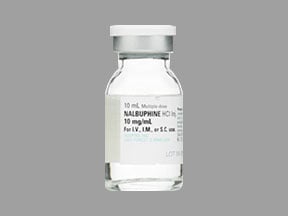
Nalbuphine Coupons & Savings Card – Discount Prices from $1.01
My prescription
Edit
1ML of 10MG/ML, Nalbuphine (1 Ampule)
Select pharmacy

CVS
$24.85
COUPON PRICE
Walmart
$1.01
COUPON PRICE
Walgreens
$5.20
COUPON PRICE
Albertsons
$7.33
COUPON PRICENalbuphine savings card
Show this card to your pharmacist
Walmart
$1.01
BIN
ID
PCN
GRP
019876
LH64B1CD6F
CHIPPO
LHX
Powered by
Related opioid agonist/antagonists prescriptions
More prescriptions for pain
Related opioid agonist/antagonists prescriptions
More prescriptions for pain
Nalbuphine dosage forms
Dosage Quantity Price from Per unit 1ML of 10MG/ML 1 Ampule $1.01 $1.01 1ML of 10MG/ML 2 Ampules $6.89 $3.44 1ML of 10MG/ML 3 Ampules $12.83 $4.28 1ML of 20MG/ML 1 Ampule $3.17 $3.17 1ML of 20MG/ML 2 Ampules $11.32 $5.66 1ML of 20MG/ML 3 Ampules $19.48 $6.49
| Dosage | Quantity | Price from | Per unit |
|---|---|---|---|
| 1ML of 10MG/ML | 1 Ampule | $1.01 | $1.01 |
| 1ML of 10MG/ML | 2 Ampules | $6.89 | $3.44 |
| 1ML of 10MG/ML | 3 Ampules | $12.83 | $4.28 |
| 1ML of 20MG/ML | 1 Ampule | $3.17 | $3.17 |
| 1ML of 20MG/ML | 2 Ampules | $11.32 | $5.66 |
| 1ML of 20MG/ML | 3 Ampules | $19.48 | $6.49 |
Nalbuphine Warnings
The following provides essential safety information regarding the use of nalbuphine. Please review these details carefully and consult your healthcare provider if you have any questions or concerns.
Respiratory Depression: Nalbuphine may cause life-threatening breathing difficulties, especially if taken with other medications that depress breathing (such as benzodiazepines, opioids, muscle relaxants, or sleep aids) or with alcohol. Inform your healthcare provider of all medications you are taking. Increased risk factors include a history of substance abuse, alcohol consumption, respiratory conditions like asthma, older age (65+), low body weight, and general frailty.
Adrenal Insufficiency: Long-term use of opioids like nalbuphine can lead to low adrenal hormone levels, presenting symptoms such as weakness, fatigue, dizziness, nausea, vomiting, and loss of appetite. Notify your healthcare provider immediately if you experience these symptoms, especially if nalbuphine is used for more than a month.
Hypotension: Nalbuphine can cause extremely low blood pressure, especially when combined with medications that depress the central nervous system, such as general anesthetics and sedatives. Your healthcare provider will monitor your blood pressure during treatment. Report any feelings of lightheadedness, dizziness, fatigue, or fainting to your provider.
Increased Intracranial Pressure: Due to its effect on lowering breathing rate, nalbuphine may increase pressure in the brain, posing risks for individuals with brain tumors, head injuries, or pre-existing high intracranial pressure. Your healthcare provider will frequently monitor your breathing and consciousness levels during treatment.
Gastrointestinal Risks: Nalbuphine can exacerbate stomach or digestive issues, increasing the risk of pancreatitis. It should not be used by individuals with intestinal blockages. Discuss any history of stomach problems with your provider, and consult them if you experience constipation while on nalbuphine.
Seizure Risk: Nalbuphine may increase the likelihood of seizures in individuals with a personal or medical history of seizures. Ensure your healthcare provider is aware of your medical history for closer monitoring if necessary.
Serotonin Syndrome: Concurrent use of nalbuphine with serotonergic medications (e.g., fluoxetine, duloxetine, MAOIs, trazodone) may lead to a potentially fatal condition called serotonin syndrome. Inform your healthcare provider about all your current medications. Seek immediate medical attention and discontinue nalbuphine if you experience symptoms like diarrhea, high fever, distress, confusion, tremors, sweating, rapid heartbeat, or muscle stiffness.
Impaired Alertness: Nalbuphine can impair alertness, causing drowsiness and reduced concentration. Your provider will assess when it is safe for you to drive or engage in tasks that require full attention.
Please ensure you discuss these risks with your healthcare provider to tailor the safest treatment plan for your needs.
Nalbuphine Side Effects
Nalbuphine is a medication used to relieve moderate to severe pain. Like all medications, it can cause side effects, ranging from common and mild to rare and serious. Common Side Effects:
- Sedation: Feeling unusually sleepy or drowsy.
- Dizziness: A sensation of lightheadedness or unsteadiness.
- Nausea and Vomiting: Feeling sick to your stomach or actually vomiting.
- Dry Mouth: A lack of moisture in the mouth.
- Headache: Experiencing pain in the head or neck area.
- Sweating: Increased perspiration.
Less Common Side Effects:
- Nervousness or Restlessness: Feeling anxious or unable to stay still.
- Depression: Persistent feelings of sadness or hopelessness.
- Unusual Dreams: Experiencing vivid or disturbing dreams.
- Confusion: Difficulty understanding or thinking clearly.
- Blurred Vision: Difficulty seeing clearly.
- Itching or Skin Rash: Irritation or redness of the skin.
Serious Side Effects:
- Respiratory Depression: Slow or shallow breathing, which can be life-threatening.
- Allergic Reactions: Symptoms may include swelling of the face, lips, or throat; difficulty breathing; or hives.
- Heart-Related Issues: Irregular heartbeat, chest pain, or low blood pressure.
- Severe Dizziness or Fainting: Feeling extremely lightheaded or actually fainting.
Important Considerations:
- Drug Interactions: Combining nalbuphine with other central nervous system depressants, such as benzodiazepines or alcohol, can increase the risk of severe sedation, respiratory depression, coma, or even death. It's crucial to inform your healthcare provider about all medications and substances you are currently using.
- Use in Specific Populations: Elderly individuals or those with existing respiratory conditions should use nalbuphine with caution due to an increased risk of serious side effects.
- Dependency and Withdrawal: Prolonged use of nalbuphine may lead to physical dependence. Abruptly stopping the medication can result in withdrawal symptoms such as anxiety, sweating, nausea, and tremors. Always consult your healthcare provider before discontinuing use.If you experience any severe or concerning side effects while taking nalbuphine, seek medical attention immediately. Always discuss potential risks and benefits with your healthcare provider before starting any new medication.
Nalbuphine Interactions
When taking nalbuphine, it's important to be aware of potential interactions with other medications and substances, as these can affect its safety and effectiveness.
Central Nervous System (CNS) Depressants: Combining nalbuphine with other substances that depress the central nervous system—such as benzodiazepines, other opioids, alcohol, sedatives, tranquilizers, muscle relaxants, general anesthetics, and antipsychotics—can lead to serious side effects. These include profound sedation, respiratory depression, coma, and even death. Therefore, such combinations should only be considered when no alternative treatments are available. If co-administration is necessary, the dosages and duration should be kept to a minimum, and patients should be closely monitored for signs of respiratory depression and sedation.
Serotonergic Drugs: Using nalbuphine alongside medications that influence serotonin levels—like selective serotonin reuptake inhibitors (SSRIs), serotonin and norepinephrine reuptake inhibitors (SNRIs), tricyclic antidepressants (TCAs), triptans, 5-HT3 receptor antagonists, and certain muscle relaxants—can increase the risk of serotonin syndrome. This condition may present with symptoms such as agitation, hallucinations, rapid heartbeat, high blood pressure, fever, nausea, vomiting, diarrhea, muscle rigidity, dizziness, tremor, and seizures. If combining these drugs is deemed necessary, patients should be carefully observed, especially during the start of treatment and when adjusting doses. Nalbuphine should be discontinued if serotonin syndrome is suspected.
Muscle Relaxants: Nalbuphine may enhance the effects of muscle relaxants, potentially leading to increased respiratory depression. Patients should be monitored for signs of excessive respiratory depression, and adjustments to the dosages of nalbuphine and/or the muscle relaxant may be required.
Diuretics: Opioids like nalbuphine can reduce the effectiveness of diuretics by promoting the release of antidiuretic hormone. Patients should be observed for decreased urine output or changes in blood pressure, and diuretic dosages may need to be increased accordingly.
Anticholinergic Drugs: Combining nalbuphine with anticholinergic medications can raise the risk of urinary retention and severe constipation, which may lead to a condition called paralytic ileus. Patients should be monitored for signs of urinary retention or reduced bowel movements when these drugs are used together.
Monoamine Oxidase Inhibitors (MAOIs): Patients should avoid taking nalbuphine while using any drugs that inhibit monoamine oxidase. Starting MAOIs while on nalbuphine is also not recommended.
It's crucial to inform your healthcare provider about all medications and supplements you're currently taking to avoid potential interactions with nalbuphine.
